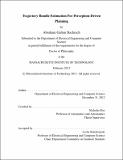Trajectory bundle estimation For perception-driven planning
Author(s)
Bachrach, Abraham Galton
DownloadFull printable version (7.903Mb)
Other Contributors
Massachusetts Institute of Technology. Department of Electrical Engineering and Computer Science.
Advisor
Nicholas Roy.
Terms of use
Metadata
Show full item recordAbstract
When operating in unknown environments, autonomous vehicles must perceive and understand the environment ahead in order to make effective navigation decisions. Long range perception can enable a vehicle to choose actions that take it directly toward its goal, avoiding dead ends. In addition, the perception range is critically important for ensuring the safety of vehicles with constrained dynamics. In general, the faster a vehicle moves, the more constrained its dynamics become due to acceleration limits imposed by its actuators. This means that the speed at which an autonomous agent can safely travel is often governed by its ability to perceive and understand the environment ahead. Overall, perception range is one of the most important factors that determines the performance of an autonomous vehicle. Today, autonomous vehicles tend to rely exclusively on metric representations built using range sensors to plan paths. However, such sensors are limited by their maximum range, field of view, and occluding obstacles in the foreground. Together, these limitations make up what we call the metric sensing horizon of the vehicle. The first two limitations are generally determined by the weight, size, power, and cost budget allocated to sensing. However, range sensors will always be limited by occlusions. If we wish to develop autonomous vehicles that are able to navigate directly toward a goal at high speeds through unknown environments, then we must move beyond the simple range-sensor based techniques. We must develop algorithms that enable autonomous agents to harness knowledge about the structure of the world to interpret additional sensor information (such as appearance information provided by cameras), and make inferences about parts of the world that cannot be directly observed. We develop a new representation based around trajectory bundles, that makes this challenging task more tractable. Rather than attempt to explicitly model the geometry of the world in front of the vehicle (which can be incredibly complex), we reason about the world in terms of what the vehicle can and cannot do. Trajectory bundles are designed to capture an abstract concept such as the command "go straight and then turn towards the right" in a concrete and actionable manner. We employ a library of trajectory bundles to reason about the layout of obstacles in the environment based on which bundles in the library are predicted to be feasible. Trajectory bundles provide a lens through which we can look at perception tasks, allowing us to leverage machine learning tools in much more effective ways for navigation. In this thesis we introduce trajectory bundles, and develop algorithms that use them to enable perception-driven planning. We develop a trajectory clustering algorithm that enables us to construct a set of trajectory bundles. We then develop a Bayesian filtering framework that enables us to estimate a belief over which trajectory bundles are feasible based on the history of actions and observations of the vehicle. We test our algorithms by using them to navigate a simulated fixed wing air vehicle at high speeds through an unknown environment using a monocular camera sensor.
Description
Thesis (Ph. D.)--Massachusetts Institute of Technology, Dept. of Electrical Engineering and Computer Science, 2013. This electronic version was submitted by the student author. The certified thesis is available in the Institute Archives and Special Collections. Cataloged from student-submitted PDF version of thesis. Includes bibliographical references (p. 113-122).
Date issued
2013Department
Massachusetts Institute of Technology. Department of Electrical Engineering and Computer SciencePublisher
Massachusetts Institute of Technology
Keywords
Electrical Engineering and Computer Science.